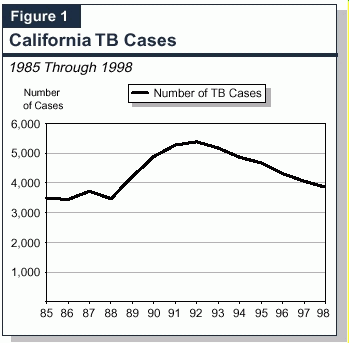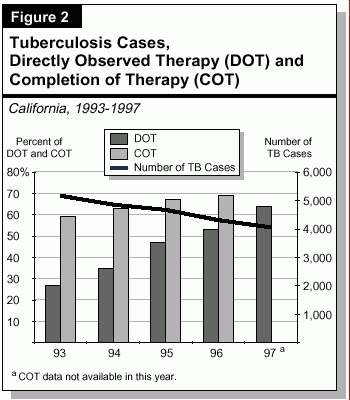

California is in its sixth consecutive year of recovery from a 1986 to 1992 resurgence of tuberculosis (TB) that boosted the state's number of TB cases by 56ápercent (see Figureá1). Compared to the peak of the epidemic in 1992, TB cases have dropped 28ápercent in California and 31ápercent nationwide (through 1998). Similarly, TB case rates (per 100,000 population) declined 32ápercent and 35ápercent, in California and the U.S. respectively, between 1992 and 1998. California's decline represents the sixth largest reduction in TB rates among the states.

The federal Centers for Disease Control and Prevention (CDC) associates the resurgence in the late 1980s with the emergence of multidrug-resistant TB (MDR-TB), the HIV/AIDS epidemic, and increased immigration from countries with high rates of TB. The CDC attributes the decline in cases to successful efforts to strengthen TB control activities.
What Is Tuberculosis?Tuberculosis (TB) is a contagious disease transmitted through the air when a person with active TB coughs or speaks. Anyone inhaling air containing the TB bacteria may become infected. The immune system usually prevents the development of the active disease. However, if untreated, about 5ápercent of those who are infected will develop active TB disease at some point in their lives. The risk is much higher for persons who have suppressed immune systems, including those with HIV infection. If active TB disease develops, it usually takes six or more months of drug therapy to cure it. Multidrug-resistant TB--active TB caused by bacteria resistant to the most powerful drugs--is much more difficult and costly to treat and may be incurable. |
Using federal and state funds totaling $85.5ámillion over six years, the Department of Health Services (DHS) has implemented intervention measures that focus on increasing the number of clients who complete their drug therapy. California's efforts appear to have had some success. Specifically, between 1993 and 1996, the percent of patients completing therapy in less than 12 months (CDC's model timeframe) increased from 59ápercent to 69ápercent. Figureá2 shows this rise in completion of therapy, as well as the decline in TB cases from 1993 through 1997 (the latest year in which complete data are available).

Completing one's TB drug regimen is critical for preventing the spread of the disease and the development of TB strains that are resistant to one or more drugs. Because medication alleviates symptoms early in the six-month treatment cycle, many patients fail to maintain their prescribed drug regimens. When the regimen is not followed, two adverse consequences occur: First, the patient can become contagious again and transmit TB to others. Second, the TB organisms within the patient can develop resistance to the TB drugs the patient has taken, creating multidrug-resistant TB. Since 1994, approximately 13ápercent of California's TB cases have developed resistance to one or more drugs.
The DHS initiated and expanded various intervention measures that served to facilitate completion of therapy, including the following:
Despite the state's gains in curtailing the disease, California still faces a formidable challenge in fighting TB.
Currently, DHS indicates that it is focusing on better identifying persons infected with TB and on increasing the percentage of patients who complete drug therapy. Specifically, the department plans to (1) increase targeted TB skin testing of high-risk groups persons in contact with infectious TB, immigrants, correctional inmates, and those with HIV infection; (2) develop activities to reduce the incidence of TB among racial and ethnic groups; and (3) expand data collection and analysis in order to better evaluate the programs' impacts and cost-effectiveness.
Contact--Karin Bloomer--(916) 445-6061
| About the LAO
California Update is published monthly--except January and February--by the Legislative Analyst's Office (LAO). The LAO is a nonpartisan office which provides fiscal and policy information and advice to the legislature. The Legislative Analyst's Office is located at 925 L Street, Suite 1000, Sacramento, CA 95814. |
Need an LAO Report?
Ľ Call (916) 445-2375. Ľ Visit our web site at: www.lao.ca.gov |
Want to Subscribe to LAO Publications?
|